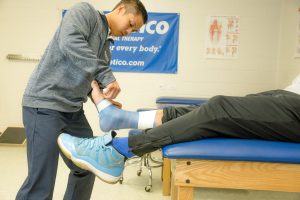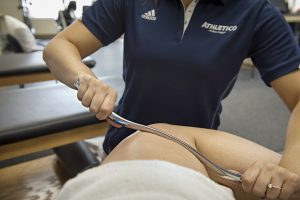Does Torn Muscle Repair Itself
Muscle mass accounts for 40-45 per centum of total body weight,one which makes it no surprise that musculus injuries can account for anywhere betwixt 10-55 percent of all sustained sports injuries.ii With such a prevalence of musculus-related injuries, it'south of import to understand how muscles heal, which includes 3 phases: Destruction, Repair and Remodeling.two
 Destruction: This phase starts when injury occurs, most probable by a contusion or strain. Ninety pct of all muscular sports injuries occur via these two mechanismsii. A contusion is a direct force to the musculus that causes injury, while a strain occurs when the muscle is subjected to excessive forces that lead to failure of the musculus fibers. During either type of injury, muscle fibers and small blood vessels tear, filling the injured area with blood. Contained within that claret are inflammatory cells that infiltrate the newly injured area. Amazingly, muscle tissue has a mechanism that "seals off" the injured area to make sure the destruction and subsequent repair phases only occur at the injured site. This process occurs throughout the first few days later on injury.1
Destruction: This phase starts when injury occurs, most probable by a contusion or strain. Ninety pct of all muscular sports injuries occur via these two mechanismsii. A contusion is a direct force to the musculus that causes injury, while a strain occurs when the muscle is subjected to excessive forces that lead to failure of the musculus fibers. During either type of injury, muscle fibers and small blood vessels tear, filling the injured area with blood. Contained within that claret are inflammatory cells that infiltrate the newly injured area. Amazingly, muscle tissue has a mechanism that "seals off" the injured area to make sure the destruction and subsequent repair phases only occur at the injured site. This process occurs throughout the first few days later on injury.1
Treatment Implications: During this phase, immobilization with braces, splints, crutches or even uncomplicated taping techniques tin exist practical. Cursory immobilization for three-seven days can help with minimizing hurting and decreasing the effects of the destruction stage to only injured tissue. Application of RICE (Rest, water ice, pinch, elevation) can also decrease the detrimental furnishings of the devastation phase.
Repair: During this important phase, a jail cell called a macrophage is introduced into the injured site. A macrophage "eats" and "cleans away" the expressionless tissue and dry claret caused by the injury. One time this is complete, another jail cell – called a satellite cell – is released into the injured expanse. Satellite cells transform into myoblast cells, which group together to create new musculus fibers. However, unlike a broken bone that is repaired by regenerating only new bone, an injured muscle is not replaced with simply new muscle fibers. Another jail cell, called a fibroblast, also produces connective tissue at the injured site. It is a combination of connective tissue and muscle fibers that repair the injured musculus. In addition, new blood vessels and nerves generate during this phase. This repair phase commonly is peaking nearly two weeks after injury.1
Treatment Implications: Transitioning from immobilization to early mobilization will occur at this time. Mobilization of the muscle can encourage faster regrowth of blood vessels and muscle fibers, also as decrease scar formation and increment tensile strength of the muscle fibers.2 The expertise of physical therapists is important during this stage, as they tin can help select the appropriate intensity of exercises. Typically gentle exercises called isometrics, in which you contract the muscle but don't allow motion of a joint or limb, will be implemented kickoff. Progression to isotonic exercises in which you strengthen the muscle through its full range of motion occurs adjacent. This, in combination with gentle stretching, is standard during the repair stage.
 Remodeling: This phase can accept a considerable overlap with the repair phase. During remodeling, the regenerating muscle fibers and connective tissue go on to mature and are existence oriented into the final scar tissue. This stage is of import for the manner in which the scar tissue is existence oriented. Typically, muscle consequence is oriented in straight lines. When the tissue repairs itself, the mixture of new muscle fibers and connective tissue is randomly oriented. Treatment during this stage can assistance the new tissue to regenerate into parallel lines, like a pile of logs, instead of i big clump, similar a ball of yarn.
Remodeling: This phase can accept a considerable overlap with the repair phase. During remodeling, the regenerating muscle fibers and connective tissue go on to mature and are existence oriented into the final scar tissue. This stage is of import for the manner in which the scar tissue is existence oriented. Typically, muscle consequence is oriented in straight lines. When the tissue repairs itself, the mixture of new muscle fibers and connective tissue is randomly oriented. Treatment during this stage can assistance the new tissue to regenerate into parallel lines, like a pile of logs, instead of i big clump, similar a ball of yarn.
Treatment implications: Manual therapy along with specialized treatment techniques such as Graston and ASTYM can aid facilitate the orientation of this new scar tissue as well as preclude restrictions in the scar tissue. This is important for decreasing the likelihood of reinjuring the tissue. Returning to regular functional action by normalizing mechanics, regaining full forcefulness through isokinetic exercises, and sports-specific training can occur during this fourth dimension.
Physical Therapists Can Help
When treating patients with musculoskeletal injuries, concrete therapists are non only selecting exercises based on the deficits that are observed during the patient's evaluation, just also identifying and respecting the current phase of healing. When combining these ii approaches, patients tin return to full activity. Taking into account the stage of healing forth with data obtained from the evaluation, allows the therapist to formulate an individualized treatment plan for optimal healing.
Schedule an date at an Athletico well-nigh you today!
Request an Appointment
The Athletico blog is an educational resources written by Athletico employees. Athletico bloggers are licensed professionals who abide by the code of ethics outlined by their corresponding professional associations. The content published in blog posts represents the opinion of the individual author based on their expertise and experience. The content provided in this blog is for advisory purposes only, does not institute medical advice and should not be relied on for making personal health decisions.
References
- Huard J, Li Y, Fu, FH. Muscle Injuries and Repair: Electric current Trends in Research. The Periodical of Os and Joint Surgery. 2002; 84-A,5: 822-832.
- Jarvinen TAH, Jarvinen TLN, Kaariainen Grand, Kalimo H, Jarvinen M. Muscle Injuries: Biology and Handling. The American Journal of Sports Medicine. 2005; 33(5): 745-764.
Does Torn Muscle Repair Itself,
Source: https://www.athletico.com/2017/03/27/understanding-the-3-phases-of-muscle-healing/
Posted by: gomezhoughts.blogspot.com



0 Response to "Does Torn Muscle Repair Itself"
Post a Comment